1998 GMC SAVANA lights
[x] Cancel search: lightsPage 7 of 388
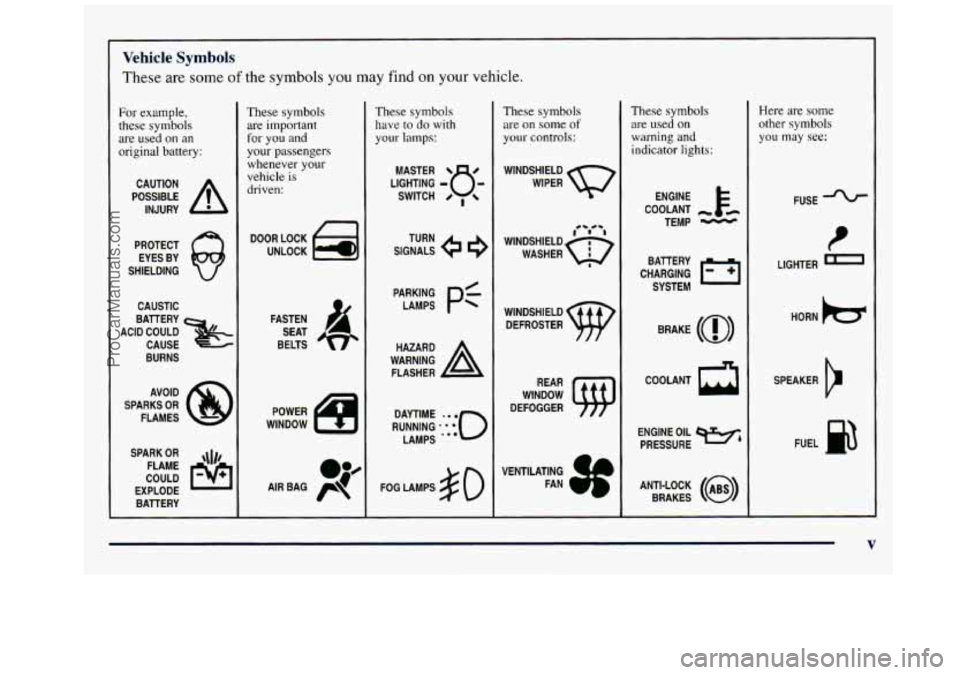
Vehicle Symbols
These are some of the symbols you may find on your vehicle.
For example,
these symbols
are used on
an
original battery:
POSSIBLE A
CAUTION
INJURY
PROTECT EYES BY
SHIELDING
CAUSTIC
BAlTERY
CAUSE
BURNS
ACID COULD
&
AVOID
SPARKS
OR
FLAMES
SPARK
OR ,\I/,
COULD FLAME
EXPLODE BATTERY
These symbols are important
for you and
your passengers whenever your
vehicle is
driven:
DOOR LOCK
UNLOCK
FASTEN SEAT
BELTS
These symbols have
to do with
your lamps:
SIGNALS e e
TURN
FOG LAMPS
$0
These symbols
are on some
of
your controls:
WINDSHIELD
WIPER
WINDSHIELD DEFROSTER
WINDOW
DEFOGGER
VENTILATING FAN
These symbols are used
on
warning and
indicator
lights:
COOLANT -
TEMP -
CHARGING l=l
BATTERY
SYSTEM
BRAKE
(0)
COOLANT a
ENGINE OIL e,
PRESSURE
ANTI-LOCK
(@)
BRAKES
Here are some
other symbols
you may
see:
FUSE -%-
P
LIGHTER m
HORN )cr
SPEAKER
b
FUEL p3
V
ProCarManuals.com
Page 73 of 388
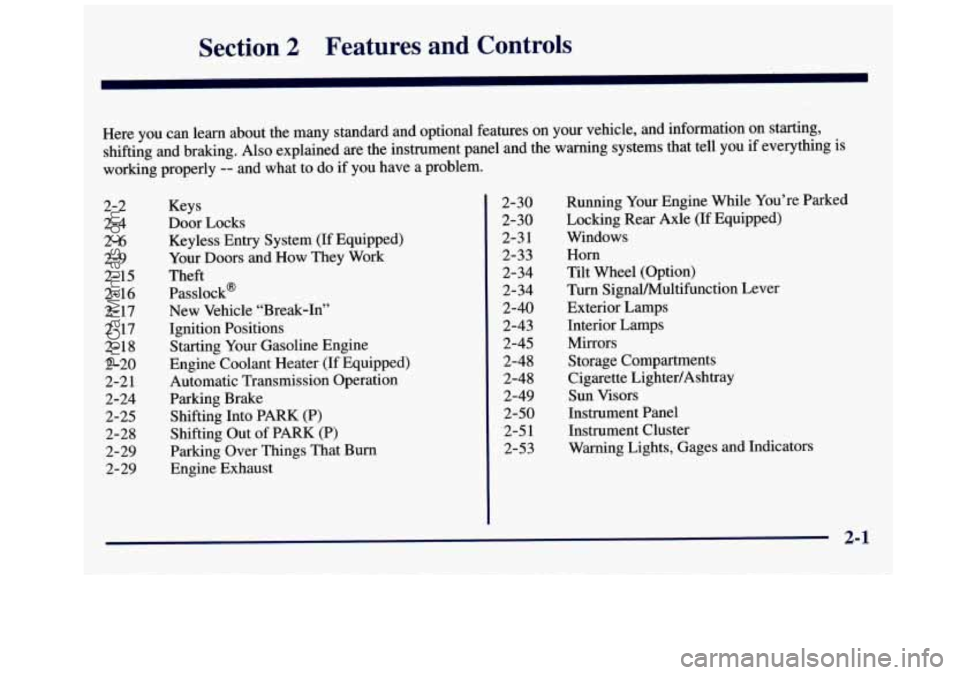
Section 2 Features and Controls
Here you can learn about the many standard and optional features on your vehicle, and information on starting,
shifting and braking. Also explained are the instrument panel and the warning systems that tell you if everything is
working properly
-- and what to do if you have a problem.
2-2
2-4 2-6
2-9
2- 15
2- 16
2- 17
2- 17
2- 18
2-20 2-2
1
2-24 2-25
2-28 2-29
2-29 Keys
Door Locks
Keyless Entry System
(If Equipped)
Your Doors and How They Work
Theft Passlock’
New Vehicle “Break-In’,
Ignition Positions
Starting Your Gasoline Engine
Engine Coolant Heater (If Equipped)
Automatic Transmission Operation
Parking Brake Shifting Into PARK (P)
Shifting Out of PARK (P)
Parking Over Things That Burn
Engine Exhaust 2-30
2-30
2-3 1
2-33
2-34
2-34
2-40 2-43
2-45
2-48 2-48
2-49
2-50
2-5 1
2-53 Running
Your Engine While You’re Parked
Locking Rear Axle (If Equipped)
Windows
Horn
Tilt Wheel (Option)
Turn SignalMultifunction Lever
Exterior
Lamps
Interior Lamps Mirrors Storage Compartments
Cigarette LightedAshtray
Sun Visors
Instrument Panel
Instrument Cluster
Warning Lights, Gages and Indicators
2-1
ProCarManuals.com
Page 112 of 388

Exterior Lamps
Your parking lamp/headlamp switch is on the driver’s
side
of your instrument panel.
Your instrument panel dimmer thumbwheel has two
detent positions.
When the thumbwheel is moved to full brilliance, and
then into the first detent position, the radio display and
PRNDL display
will go to the day mode (full intensity).
This is known as “parade” mode. The rest
of the UP
illumination
will stay in the maximum dimming state
(full brilliance dimming). Moving the thumbwheel up one
more detent will activate the interior dome light
circuit (with slightly higher effort).
The dome lights cannot be turned
on by depressing the
dome light switch button located below the parking
lampheadlamp knob. This switch is a dome lamp off
switch and will
only interrupt inputs from the door jamb
switches inhibiting interior light operation when
depressed. It will not inhibit
the light function from the
I/P dimmer switch,
The delayed entry feature will allow
you to enter or exit
your vehicle with the lights staying on for about
20 seconds, after the door is closed or ignition is cycled.
Rotate the knob to the right to the parking lamp symbol
to turn on:
0 Parking Lamps
0 Sidemarker Lamps
Taillamps
License Plate Lamps
0 Instrument Panel Lights
0 Ashtray Lamp
Rotate the knob
to the right again to the master lighting
symbol to turn on all the lamps listed above as well as
the headlamps.
2-40
ProCarManuals.com
Page 113 of 388
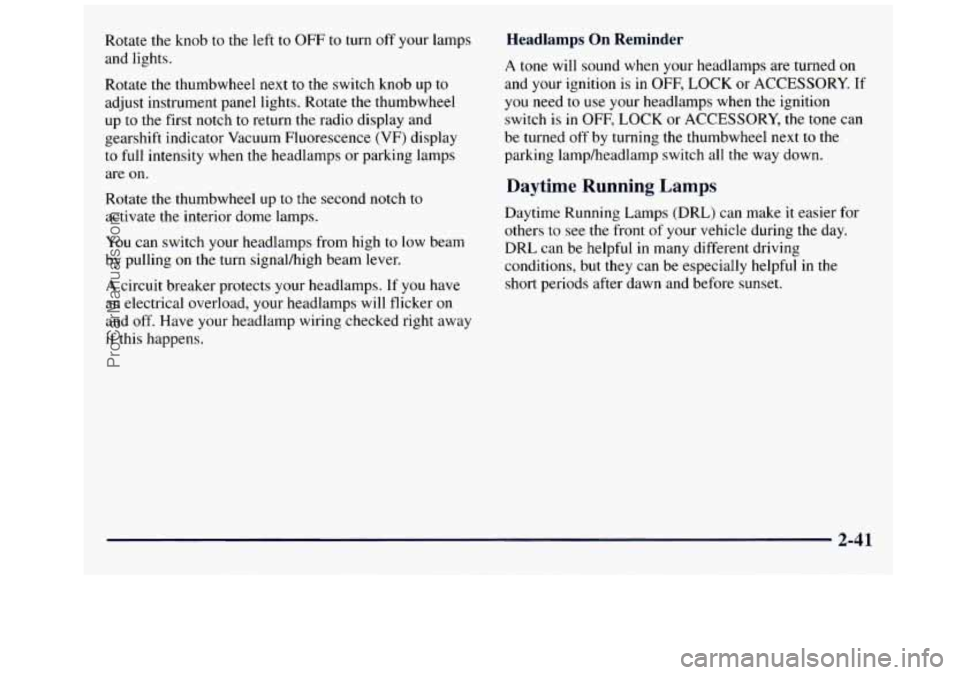
Rotate the knob to the left to OFF to turn off your lamps
and lights.
Rotate the thumbwheel next to the switch knob up to
adjust instrument panel lights. Rotate the thumbwheel
up to the first notch to return the radio display and
gearshift indicator Vacuum Fluorescence (VF) display
to full intensity when the headlamps or parking lamps
are on.
Rotate the thumbwheel up to the second notch
to
activate the interior dome lamps.
You can switch your headlamps from high
to low beam
by pulling on the turn signal/high beam lever.
A circuit breaker protects your headlamps. If you have
an electrical overload, your headlamps will flicker on
and off. Have your headlamp wiring checked right away
if this happens.
Headlamps On Reminder
A tone will sound when your headlamps are turned on
and your ignition is in OFF, LOCK or ACCESSORY. If
you need to use your headlamps when the ignition
switch
is in OFF, LOCK or ACCESSORY, the tone can
be turned
off by turning the thumbwheel next to the
parking lamp/headlamp switch all the way down.
Daytime Running Lamps
Daytime Running Lamps (DRL) can make it easier for
others to see the front
of your vehicle during the day.
DRL can be helpful in many different driving
conditions, but they can be especially helpful in the
short periods after dawn and before sunset.
2-41
ProCarManuals.com
Page 125 of 388

Electronic Road-Speed Governor
(Gasoline Engines) (Option)
This optional system automatically controls vehicle top
speed. The system controller receives
a signal from the
vehicle speed sensor and reduces power when the
vehicle speed reaches the maximum
65 mph (105 kdh)
governed speed.
Warning Lights, Gages
and Indicators
This part describes the warning lights and gages that
may be on your vehicle. The pictures will help you
locate them.
Warning lights and gages can signal that something is
wrong before it becomes serious enough to cause an
expensive repair or replacement. Paying attention to
your warning lights and gages could also save you or
others from injury.
Warning lights come on when there may be or is a
problem with one of your vehicle’s functions. As you
will see in the details
on the next few pages, some
warning lights come
on briefly when you start the
engine just to let you know they’re working.
If you are
familiar
with this section, you should not be alarmed
when this happens. Gages
can indicate when there may be or is
a problem
with one of your vehicle’s functions. Often gages and
warning lights work together to let you know when
there’s
a problem with your vehicle.
When one of the warning lights comes on and
stays on
when you are driving, or when one of the gages shows
there may be a problem, check the section that tells you
what to do about it. Please follow this manual’s advice.
Waiting to do repairs can be costly
-- and even
dangerous.
So please get to know your warning lights
and gages. They’re
a big help.
Safety Belt Reminder Light
When the key is turned to RUN or START, a tone will
come on for about eight seconds to remind people to
fasten their safety belts, unless the driver’s safety belt is
already buckled.
The safety belt light will
also come on and stay on
for about
20 seconds, then it
will flash for about
5 5 seconds.
If the driver’s belt is already buckled, neither the tone
nor the light will come on.
2-53
ProCarManuals.com
Page 179 of 388
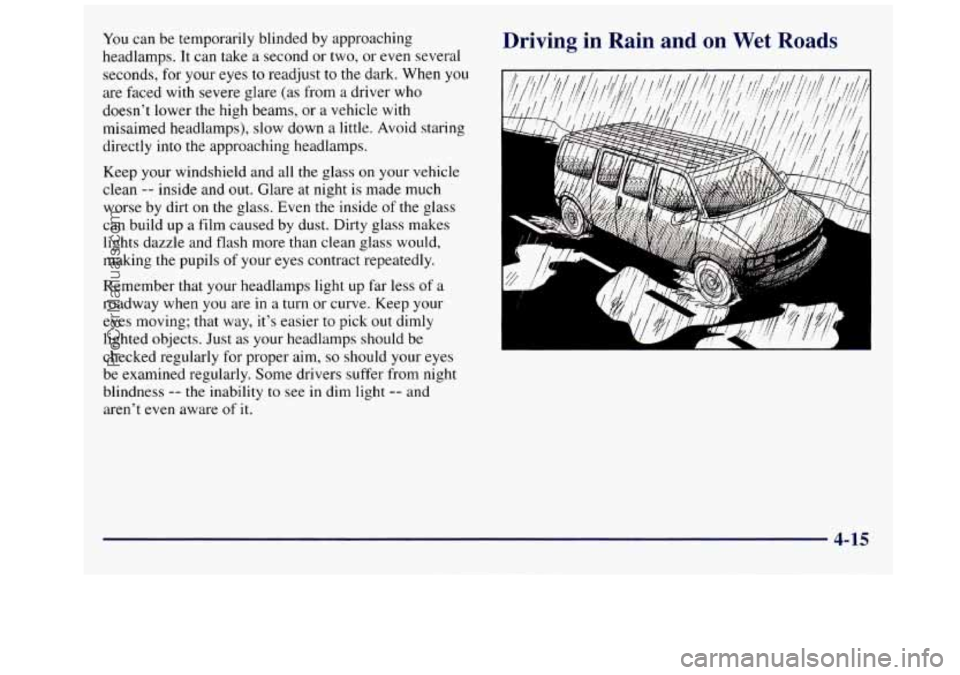
You can be temporarily blinded by approaching
headlamps. It can take a second or two, or even several
seconds, for your eyes to readjust
to the dark. When you
are faced with severe glare (as from a driver who
doesn’t lower the high beams, or a vehicle with
misaimed headlamps), slow down a little. Avoid staring
directly into the approaching headlamps.
Keep your windshield and all the glass
on your vehicle
clean
-- inside and out. Glare at night is made much
worse by dirt on the glass. Even the inside
of the glass
can build up
a film caused by dust. Dirty glass makes
lights dazzle and flash more than clean glass would,
making the pupils of your eyes contract repeatedly.
Remember that your headlamps light up far less of a
roadway when you are
in a turn or curve. Keep your
eyes moving; that way, it’s easier to pick out dimly
lighted objects. Just as your headlamps should be
checked regularly for proper aim,
so should your eyes
be examined regularly. Some drivers suffer from night
blindness
-- the inability to see in dim light -- and
aren’t
even aware of it.
Driving in Rain and on Wet Roads
.- .- -
4-15
ProCarManuals.com
Page 261 of 388

Rear Axle What to Use
When to Check and Change Lubricant
Refer to the Maintenance Schedule to determine how
often to check the lubricant and when to change it. See
“Scheduled Maintenance Services” in the Index.
How to Check Lu’_ -~I
If the level is below the
bottom of the filler plug
hole, you’ll need
to add
some lubricant. Add enough
lubricant to raise the level
to the bottom of the filler
plug hole. Refer
to the Maintenance Schedule to determine what
kind of lubricant to use. See “Recommended Fluids and
Lubricants”
in the Index.
Engine Coolant
The cooling s stem in your vehicle is filled with
DEX-COOL engine coolant. This coolant is designea
to remain
in your vehicle for 5 years or 150,000 miles
(240 000 km) whichever occurs first, if you add only
DEX-COOL6 extended life coolant.
The following explains your cooling system and how to
add coolant when it is low. If you have
a problem with
engine overheating, see “Engine Overheating” in the
Index.
A 50/50 mixture of water and DEX-COOL@
coolant will:
2
0 Give freezing protection down to -34°F (-37°C).
Give boiling protection up to 265 “F (129” C).
0 Protect against rust and corrosion.
0 Help keep the proper engine temperature.
0 Let the warning lights and gages work as
they should.
6-21
ProCarManuals.com
Page 384 of 388
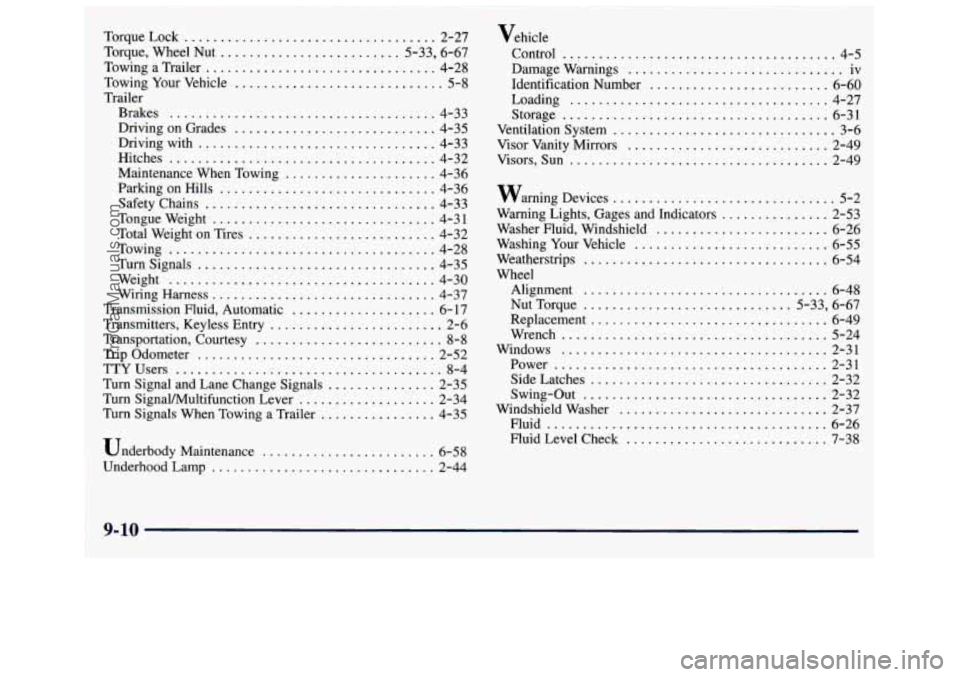
TorqueLock ................................... 2-27
rorque. Wheel Nut ......................... 5.33. 6.67
Towing a Trailer ................................ 4-28
Towing Your Vehicle ............................. 5-8
Driving on Grades ............................ 4-35
Driving with ................................. 4-33
Parking on Hills .............................. 4-36
Safety Chains ................................ 4-33
Tongue Weight ............................... 4-3 1
Total Weight on Tires .......................... 4-32
Towing ..................................... 4-28
Turn Signals ................................. 4-35
Weight ..................................... 4-30
Wiring Harness ............................... 4-37
Transmission Fluid, Automatic .................... 6- 17
rransmitters, Keyless Entry ........................ 2-6
Transportation, Courtesy .......................... 8-8
Trip Odometer ................................. 2-52
Turn SignaVMultifunction Lever ................... 2-34
Trailer
Brakes
...................................... 4-33
Hitches ..................................... 4-32
Maintenance When Towing ..................... 4-36
TTYUsers ..................................... 8-4
Turn Signal and Lane Change Signals ............... 2-35
Turn Signals When Towing a Trailer ................ 4-35
Underbody Maintenance .............. ,. ......... 6-58
Underhood Lamp ............................... 2-44
Vehicle
Control
...................................... 4-5
Damagewarnings .............................. iv
Identification Number
......................... 6-60
Loading .................................... 4-27
Storage ..................................... 6-31
Ventilation System ............................... 3-6
Visor Vanity Mirrors ............................ 2-49
Visors. Sun .................................... 2-49
warning Devices ............................... 5-2
Warning Lights. Gages and Indicators ............... 2-53
Washer Fluid. Windshield ........................ 6-26
Washing Your Vehicle ........................... 6-55
Weatherstrips .................................. 6-54
Wheel
Alignment
.................................. 6-48
Nut Torque ............................. 5-33. 6-67
Replacement ................................. 6-49
Wrench ..................................... 5-24
Windows ..................................... 2-31
Power ...................................... 2-31
SideLatches ................................. 2-32
Swing-Out .................................. 2-32
Windshield Washer ............................. 2-37
Fluid ....................................... 6-26
Fluid Level Check ............................ 7-38
9-10
ProCarManuals.com